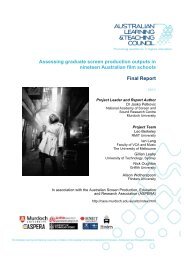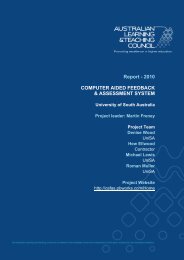offer both encouraging <strong>and</strong> discouraging elements. The encouraging element is thatthe family is highly valued in Chinese culture. Three or more generations livingunder one roof is considered a very good indication of harmony <strong>and</strong> happiness inthe family. The discouraging element is the expectation of their children: “to benumber one in the school/university” is common among Chinese parents. To enableChinese students to successfully complete group projects, a balanced approachtaking into consideration these two cultural elements would be appropriate.Universities in Australia could start working on language challenges <strong>for</strong> internationalstudents be<strong>for</strong>e they arrive in Australia (even be<strong>for</strong>e they are offered a place inAustralian universities). The authors/researchers would like to suggest a multichannelstrategy, which involves many relevant parties, <strong>and</strong> both technological <strong>and</strong>non-technological tools/solutions. Australian universities could work through theirown overseas offices <strong>and</strong> staff, collaborate with their overseas partners (includingagents, educational partners <strong>and</strong> other associated organisations), <strong>and</strong> work withgraduates who return to their home countries or with graduates who are residing orworking in the overseas countries.In consideration of the issues raised above, we offer the following suggestions <strong>for</strong>Australian universities:1. Produce digital (i.e., CD, DVD) <strong>and</strong> printed materials, such as academicskills booklet <strong>for</strong> first year students covering various perspectives of teaching<strong>and</strong> learning in Australian universities (such as the use of textbooks <strong>and</strong>study materials, student-centred approach, different credit points systems<strong>and</strong> course/subject selection processes, group activities), Australian culture<strong>and</strong> social environment in<strong>for</strong>mation, university life in Australia, <strong>and</strong> someunique words <strong>and</strong> Australian English slang. Such materials should bedistributed to international students in their home countries via theuniversities’ own offices <strong>and</strong>/or representations as well as agents <strong>and</strong>partners in their home countries.2. Establish an online repository to store <strong>and</strong> distribute the in<strong>for</strong>mationdiscussed in the last point. This repository should be available to everyone.3. Operate academic preparation <strong>and</strong> orientation week programs in their homecountries be<strong>for</strong>e they depart. Such programs could be run by universitiesthemselves <strong>and</strong>/or through their overseas partners.4. Use graduates in the home countries of international students to educatethem on teaching, learning <strong>and</strong> living in Australia. The real life experiences ofAustralian graduates are much better <strong>and</strong> much more effective than otherinitiatives (i.e., all <strong>for</strong>ms of publications <strong>and</strong> databases, various academic<strong>and</strong> orientation programs) in helping international students underst<strong>and</strong>Australia <strong>and</strong> its education system.5. Put in place mentor programs in the home countries of internationalstudents. Those graduates are very good mentors <strong>for</strong> students who aregoing to Australian universities to study in the home countries.6. Provide assistance to international students be<strong>for</strong>e they leave their homecountries through Australian university offices, representations <strong>and</strong> theirpartners, as well as via multiple touch points (i.e., fax, telephone, Internet,face-to-face, post, email, SMS). This assistance includes airport pickuparrangements (via working with internal staff <strong>and</strong> travel firms),accommodation booking (via working with internal staff <strong>and</strong> real estateagents), <strong>and</strong> banking services (via working with banks).129
7. Arrange peer groups <strong>for</strong> those students who coming to the same city(preferably going to the same university) be<strong>for</strong>e they depart, so that they canhave friends be<strong>for</strong>e they arrive in Australia. Such arrangements will bethought of highly by many Chinese students <strong>and</strong> their families, since theybelieve “while you are at home, you rely on your family; while you are awayfrom your family, you seek assistance from your friends”.7.2 Enhancing teaching <strong>and</strong> learning during studyThese teaching <strong>and</strong> learning activities provided to international students be<strong>for</strong>e theystart their study aim principally at increasing the students’ awareness of teaching<strong>and</strong> learning practices <strong>and</strong> introducing them the way of studying <strong>and</strong> living inAustralia. Many issues discussed in the previous section on perspectives ofteaching content <strong>and</strong> textbooks, teaching <strong>and</strong> learning methods, educationmanagement systems, language, culture <strong>and</strong> environment become more obvious<strong>and</strong> need to be dealt with more specifically during international students’ timestudying at Australian universities.In general, we suggest that Australian universities need to promote a newphilosophy of teaching which combines both student-centred <strong>and</strong> teacher-centredteaching <strong>and</strong> learning approaches to deal with the increased international studentcohort.Some specific suggestions include:1. Educate students on required academic skills via academic preparationprograms <strong>and</strong>/or orientation programs <strong>and</strong>/or specific workshops <strong>and</strong>seminars.2. Educate students on Australian culture, the social environment in Australia,Australian slang, <strong>and</strong> the Australian way of teaching/learning <strong>and</strong> living viaacademic preparation programs <strong>and</strong>/or orientation programs <strong>and</strong>/or specificworkshops <strong>and</strong> seminars.3. Provide mentoring programs to international students <strong>and</strong> recruit both local<strong>and</strong> international senior students as mentors. Ideally teams of mentorsincluding staff, international students, <strong>and</strong> local students should be availableto international students.4. Ensure international students can settle down smoothly by providing variousassistance <strong>and</strong> services through the combined <strong>for</strong>ces of staff, seniorstudents, students’ families, communities <strong>and</strong> relevant parties (i.e., banks,real estate agencies, transportation authorities, fair trading departments,police, immigration departments).5. Provide sufficient resources (i.e., staff <strong>and</strong> time) to offer adequateconsultations to international students (especially newly-arrived ones) onunderst<strong>and</strong>ing <strong>and</strong> applying education management systems in Australia(i.e., provide guidelines <strong>and</strong> recommendations on how to select subjects <strong>and</strong>courses). Staff working in those areas should be academics or general staffwho have a very good knowledge of academic practice <strong>and</strong> procedure. Inaddition, lecturers should allocate more consultation time to newinternational students to help them adapt to the new study environment morequickly <strong>and</strong> smoothly.6. Establish language <strong>and</strong> study skills assistance to international students viadesignated centres <strong>and</strong> staff, <strong>and</strong> actively promote those centres tointernational students. They should use learning assistance as much aspossible.7. Facilitate peer teams or study groups among students (ideally each130
- Page 1 and 2:
Strategies and Approaches toTeachin
- Page 3 and 4:
Table of Contents0 EXECUTIVE SUMMAR
- Page 5:
0 Executive SummaryAustralian terti
- Page 8 and 9:
1 Project OutcomesThe outcomes of t
- Page 10 and 11:
The identification information sect
- Page 12:
questions aim to discover their ass
- Page 15 and 16:
3.2 Literature reviewCross-cultural
- Page 17 and 18:
4 Survey Data AnalysisThis section
- Page 19 and 20:
Total Count 380 632 1012Percentage
- Page 21 and 22:
2 Count 12 30 42Percentage 3.1% 4.7
- Page 23 and 24:
Table 13 shows that nearly all loca
- Page 25 and 26:
methods are good, while less than h
- Page 27 and 28:
Preferredfewerlectures andmore labs
- Page 29 and 30:
Table 26 (Question III.4.D) Preferr
- Page 31 and 32:
Maindifferencesbetweenteachingmetho
- Page 33 and 34:
Table 33 shows that about half of l
- Page 35 and 36:
Table 38 (Question IV.4) Sufficient
- Page 37 and 38:
understanding lectures?Table 42 (Qu
- Page 39 and 40:
confident Count 301 179 480Percenta
- Page 41 and 42:
Table 49 (Question VI.4) Caring abo
- Page 43 and 44:
Table 52 shows that more local stud
- Page 45 and 46:
Table 56 shows that both local and
- Page 47 and 48:
a chi-square test to determine whet
- Page 49 and 50:
Significance Level (α= 0.05)Hypoth
- Page 51 and 52:
presentations are unrelated (Indepe
- Page 53 and 54:
Hypotheses V.2H0: Student category
- Page 55 and 56:
encountered at university in 2/3/4
- Page 57 and 58:
III.7What are you most concerned ab
- Page 59 and 60:
II.6.EII.6.FII.6.GTextbooks you pre
- Page 61 and 62:
VII. OtherVII.1.1VII.1.2What are th
- Page 63 and 64:
III.6 Do you like lecturers to ask
- Page 65 and 66:
distribution of these comments acro
- Page 67 and 68:
Figure 4.5 University of Sydney und
- Page 69 and 70:
Australia is the environment (11.06
- Page 71 and 72:
example, one student said that home
- Page 73 and 74:
5 Interview Data AnalysisThis secti
- Page 75 and 76:
class?Eight students thought studen
- Page 77 and 78:
(1) Did you have any difficulty sel
- Page 79 and 80: 5.2 Staff interview data analysisA
- Page 81 and 82: (2) Do you think that the methods y
- Page 83 and 84: is the biggest problem”. One lect
- Page 85 and 86: comments was, “No, I send them to
- Page 87 and 88: lecturer, and one of them like the
- Page 89 and 90: am a shy person I am not comfortabl
- Page 91 and 92: When they have difficulties in read
- Page 93 and 94: (7) Have you been involved in many
- Page 95 and 96: Only two of the graduates had diffi
- Page 97 and 98: Furthermore, I was not familiar wit
- Page 99 and 100: ased communication style such as e-
- Page 101 and 102: CrosstabDifficultieswhenreadingtext
- Page 103 and 104: CrosstabPreferred workingin groups
- Page 105 and 106: CrosstabMain differencesbetween tea
- Page 107 and 108: CrosstabWhat are the maindifficulti
- Page 109 and 110: CrosstabDo you have anyEnglish lang
- Page 111 and 112: CrosstabDo you have anyEnglish lang
- Page 113 and 114: CrosstabAre you confidentabout your
- Page 115 and 116: CrosstabDo you have anyEnglish lang
- Page 117 and 118: CrosstabWhat are the mainstudy diff
- Page 119 and 120: Pearson Chi-SquareLikelihood RatioN
- Page 121 and 122: ead lecture notes.2. Regarding the
- Page 123 and 124: II.9 0.022 0.097 0.174 0.02 0.135II
- Page 125 and 126: From Table 65, we can see that ther
- Page 127 and 128: countries peoples. Personally, I fi
- Page 129: perceived by them as something insi
- Page 133 and 134: covered (or not covered well) in th
- Page 135 and 136: 13. Ask assistance from internation
- Page 137 and 138: 11) • Weekly groupcase studies an
- Page 139 and 140: 8 Guideline for International Stude
- Page 141 and 142: life. However, it is very important
- Page 143 and 144: There are ways of maintaining focus
- Page 145 and 146: Expect to be nervous initially and
- Page 147 and 148: Avoid cheating and plagiarismAustra
- Page 149 and 150: 9 Disciplinary and interdisciplinar
- Page 151 and 152: 10 Results communication, publicati
- Page 153 and 154: Visiting Professor Javier Montero f
- Page 155 and 156: 11 ReferencesAsmar C. (1999), Schol
















